英语人教版六年级上册b learn
新人教(PEP)六年级英语上册《Unit4 B let's learn》精品教案

《Unit4 B let's learn》精品教案第四课时一、教学内容本课时的教学内容是人教版小学英语六年级上册 B Let’s learn Let’s practise C Story time二、教学目标1.能够听、说、读、写五个动词的第三人称单数形式:lives,teaches,goes,watches,reads。
2.能够听、说、认读句子:Does your pen pal live in Shanghai? No,he doesn't.He lives in Beijing.3.能够听懂、说唱歌谣“Tell me about your pen pal"。
4.能够听懂、理解Story time中的故事。
三、教学重难点1.本课时的教学重点是听、说、读、写掌握五个动词的第三人称单数形式。
2.本课时的教学难点是区别使用后缀s和es。
四、教学准备1.教师准备录音机及录音带。
2.教师准备A、B部分let's learn的单词卡片。
3.教师准备一些动物单词卡片和第一单元Let's learn部分的单词卡片。
4.教师准备Story time部分的挂图和一只玩具猴。
五、教学过程Step 1 Leading-in1.Sing songs “How do you go to school?”and “My pen pal”.2. Let’s chant.Tell me about your pen pal. What does he like to do?His hobby is pain ting, and that’s my hobby too!How does he go to school ? Does he go to school by car?No, he goes on foot, because his school is not too far.3. Free talkT:Hello, boys and girls. How are you?How do you go to school?What’s your hobby?4. Play a game 英语夏令营有来自不同国家的小朋友,猜猜他们来自哪里。
人教PEP版小学英语六年级上册Unit2 B Let’s learn课件
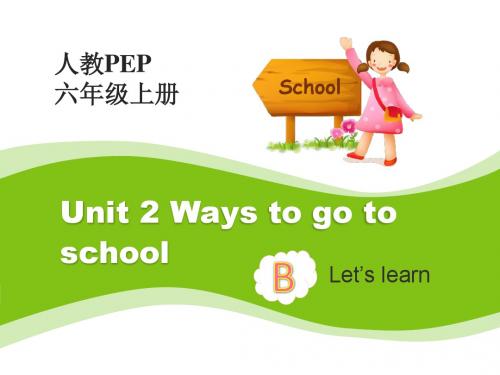
>>Practice
选词填空。
go traffic lights stop traffic rules traffic rules wait
Village Mouse: What’re those? They have 3 eyes, red, yellow and green. City Mouse: Oh, they are_______ traffic _______. lights Village Mouse: But why do they have 3 colours? City Mouse: Because there are _______ traffic_______. rules Look! It’s a red light. Let’s_______! stop Village Mouse: Oh, I see. Stop at a red light. It’s yellow. Can we go? City Mouse: No,_______ go wait at a yellow light. It’s green now. Let’s_____. Village Mouse: So these are the________ ______. I remember now. traffic rules
>>Practice
打开U2 B Let’s learn 单词训练,即学即练, 检测当堂学习情况。
>>Summary
Traffic rules:
Stop and wait at a red light. Slow down and stop at a yellow light. Go at a green light.
小学英语六年级上册Unit 2 part B Learn & Talk & Read

museum
library
Post office
A
B
Where is the post office?
book store
cinema
post chool
It’s east of the cinema. Turn left at the cinema, then go straight. It’s on the left.
Sarah The letter is from______, Amy and the letter is to______ How old is Sarah? Sarah is 12 years old.
When is her birthday party? Her birthday party is at 6 pm on Saturday.
5. How can I get to the park?
hospital cinema park school
Go straight, then turn right. ____________________________
____________________________
The park is on the left.
book store
cinema
post office
hospital park
school
Where is the hospital?
book store
cinema
post office
hospital park
school
Is it far from our school?
No, it’s not far. Turn right at the school. Then go straight. It’s on the left.
英语人教版六年级上册B.Let's learn
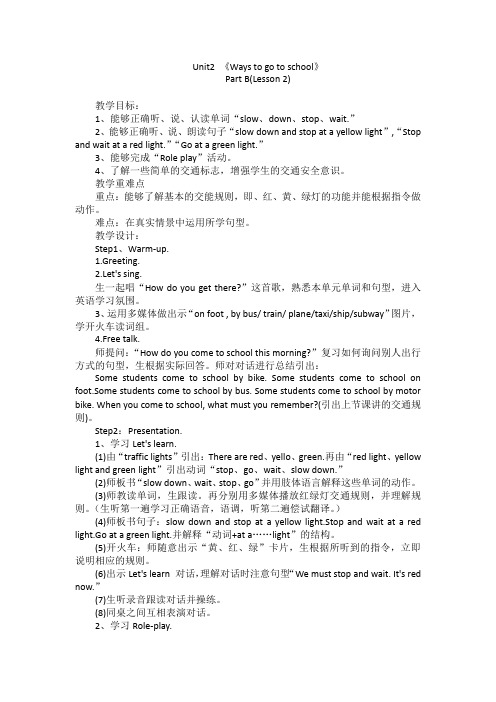
Unit2 《Ways to go to school》Part B(Lesson 2)教学目标:1、能够正确听、说、认读单词“slow、down、stop、wait.”2、能够正确听、说、朗读句子“slow down and stop at a yellow light”,“Stop and wait at a red light.”“Go at a green light.”3、能够完成“Role play”活动。
4、了解一些简单的交通标志,增强学生的交通安全意识。
教学重难点重点:能够了解基本的交能规则,即、红、黄、绿灯的功能并能根据指令做动作。
难点:在真实情景中运用所学句型。
教学设计:Step1、Warm-up.1.Greeting.2.Let's sing.生一起唱“How do you get there?”这首歌,熟悉本单元单词和句型,进入英语学习氛围。
3、运用多媒体做出示“on foot , by bus/ train/ plane/taxi/ship/subway”图片,学开火车读词组。
4.Free talk.师提问:“How do you come to school this morning?”复习如何询问别人出行方式的句型,生根据实际回答。
师对对话进行总结引出:Some students come to school by bike. Some students come to school on foot.Some students come to school by bus. Some students come to school by motor bike. When you come to school, what must you remember?(引出上节课讲的交通规则)。
Step2:Presentation.1、学习Let's learn.(1)由“traffic lights”引出:There are red、yello、green.再由“red light、yellow light and green light”引出动词“stop、go、wait、slow down.”(2)师板书“slow down、wait、stop、go”并用肢体语言解释这些单词的动作。
六年级英语上册第二单元 B部分 let's learn教案

人教版六年级上册英语第二单元第四课时一、教学内容:B部分let’s learn二、教学目标:1、能够听、说、读、写单词 slow,down,stop及短语slow down。
2、能在实际情境中熟练运用句子Stop and wait at a red light.Slow down and stop at a yellow light.Go at a green light.3、了解一些简单的交通标志,增强学生的交通意识。
三、教学重点、难点:重点:掌握四会单词及短语slow,down,stop及短语slow down。
难点:能在实际情境中熟练运用句子Stop and wait at a red light.Slow down and stop at a yellow light.Go at a green light.四、教法与学法:点拨法、小组合作法、情景教学法。
五、教学准备:相应的教学图片、录音材料、自制交通信号灯。
六、教学过程:Step1 Warming-up1.Greeting2.兔子舞,随着音乐的指令,队伍开始慢慢向前移动。
3Let’s chant“How do you get there?”两遍4.free talkT:Good morning!How do you come to school?复习如何询问别人出行方式句型。
学生可根据实际情况进行回答。
教师由对话总结引出T:Some students come to school by bike,some students come to school on foot.When you come to school,what must you remember?引出交通规则。
Step2 Presentation1.Let’s learn(1)再次总结交通规则,完成探究性学习第一题。
T:大家听一听MIKE有哪些地方做的不对,他应该怎么做呢?(2)由traffic lights 引出There are red ,yellow and green.Red means stop,green means go,yellow means wait.(3)教师板书新单词,用肢体语言解释做slow down,wait,stop,go的动作。
人教PEP版英语六年级上册-Unit 5 B Let’s learn 教案

Unit 5 What does he do?
Part B Let’s learn
一、教学目标
1.能够听、说、读、写有关职业的词:fisherman, scientist, pilot, coach
2.能够在实际情景中运用句型“What does he/she do? Where does he/she work?”谈论职业和工作地点。
3. 能够掌握第三人称单数。
4. 能从不同视角认识职业,理解职业精神。
二、教学重难点
重点:
1.能够听、说、读、写有关职业的词:fisherman, scientist, pilot, coach
2.能够在实际情景中运用句型“What does he/she do? Where does he/she work?”谈论职业和工作地点。
3. 能够掌握第三人称单数。
难点:
能够在实际情景中运用句型“What does he/she do? Where does he/she work? ”谈论职业和工作地点。
三、教学准备
课件,音频,视频
五、板书设计
Unit 5 What does he do?
Part B Let’s learn
Words:
fisherman, scientist, pilot, coach
Sentences:
—Where does he/she work?
—He/She works…。
PEP英语六年级上Unit 4 B Learn
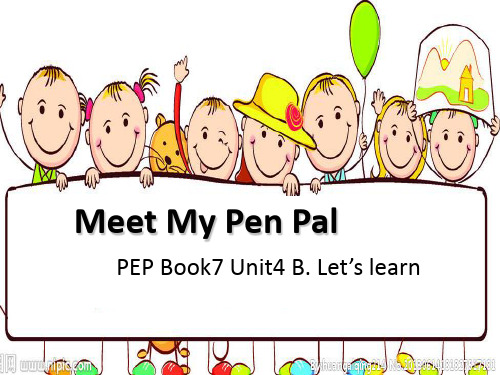
goes hiking
g → goes o
She goes hikingevery weekend.
What do they do every weekend?
He/She _________ every weekend.
HeS/hSehdeo_es_h_o_m_e_w_o_r_k eevveerryywweeeekkeenndd..
Chinese food? Yes, she does. No, she
Hey, Zhang Peng. Come and see my new pen pal. Her name is WherKeatdeo.es she come from?
She comes from the USA, but she lives in Hangzhou now.
Kate is my new pen pal. We write e-mails to each other.
Hale Waihona Puke She comes from the USA. But she lives in Hangzhou now.
She likes doing word puzzles. She does word puzzles every day.
Great!Does she like China?
Yes, she does. She loves China. She studies Chinese every week.
Cool! Does she also like Chinese food?
Yes, she does. She likes dumplings(水饺)and mooncakes.
人教PEP版英语六年级上册Unit4 PartB Let's learn(课件)

THANKS
VIEWINGS
likes lives draws cooks studies does goes watches
ቤተ መጻሕፍቲ ባይዱ
主语三单动词变, 类似名词变复数。 普通词尾加s, 特殊变化有几处。
sh,s,ch,x, 后面都加es. 辅加o,es too. 辅加y,y变i have 变has 常用又特殊
Let’s learn
John is talking with his brother about his pen pal. Listen and answer.
1.Does Jonh live in China? 2.Does he go to school by ship? 3.Does he go hiking in the morning? 4.Does he cook Chinese food?
Yes,he does. No,he doesn’t.
1. What is his name? His name is John,too!
2. Does he live in China?
助动词,是不是?
No,he doesn't.He lives in Australia.
3. Does he study Chinese?
Yes, he does.
Listen and imitate
Look and say
I live in ... .
He lives in ... .
Let’s learn
I cook English food. He cooks Chinese food.
Let’s learn
studies Chinese.
人教版PEP六年级上册英语第三单元教学课件 B Learn

(John wants to buy some books this Sunday.)
______________________? Where is John going
He is going to the bookstore __________________________.
John is going to buy some books for his family.
What are you going to buy?
I am going to buy a dictionary.
comic book word book
postcard
Summary: Where are you going?
I am going to the bookstore. 1,听录音并跟读课文5分钟。 What are you going to buy? I2 am going to buy a dictionary. ,抄写新学单词和词组 5遍,准备听写。 3,预习课文P28.
magazine
football magazine
art magazine
travel magazine
John’s father likes travelling(旅游).
I’m going to buy
a travel magazine for my dad. ______________
for his cousin, Jack.
They are in the bookstore, too. What are they going to buy?
Listen and find 听音,回答
比听力,还 比记忆力
I’m going to buy _______.
2024年人教版PEP英语六年级上册Unit 4 B Let's learn-课件

talk about:谈论关于....
What are they talking about? They are talking about a pen pal.
Role play
角色扮演
总结
这节课我学习了句型: What are you doing? I'm doing ...... Does he like doing word puzzle? Yes,he does./No,he doesn’t. 。
口头读翻译: 1.她喜欢去远足吗? 2.你正在干什么? 3.他居住在中国,河南,三门峡。 4.Mona 喜欢做中国菜。 5.这个女孩每天学习语文。
找出下列句子的正确答语。
Does he live in China? Next Monday. What are your hobbies? Yes,I can. What are you doing? Singing and dancing. Where does he live? I'm writing an e-mail. Can you do kung fu? Yes,he does. What are you going to do? He lives in Australia. When are you going? I'm going shopping.
Hi!My name’s !I’m very interested in Australia,and I’m Learning English. Write to me or chat writh me.Let’s be friends
MY HOBBIES ICAN SPEAK ,Chinese
read – look – work – say – run – go – do – watch – teach – have –
六年级上册英语教学设计《Unit3Myweekendplan-3Blearn》人教(PEP)

六年级上册英语教学设计《Unit3 My weekend plan-3 B learn》人教(PEP)一. 教材分析本课是人教(PEP)六年级上册英语第三单元《My weekend plan》的第3部分B learn。
本部分通过听、说、读、写等活动,让学生学会用一般将来时谈论周末计划,并能够正确运用目标语言进行简单的交流。
教材内容贴近学生的生活,有利于激发学生的学习兴趣和参与欲望。
二. 学情分析六年级的学生已经具备了一定的英语基础,能够听、说、读、写一些简单的句子。
但部分学生对一般将来时的运用还不够熟练,需要在课堂上进行有针对性的练习和巩固。
三. 教学目标1.能听懂、会说、会读本课的生词和句子,并能正确运用一般将来时进行简单的交流。
2.能根据实际情况制定周末计划,并能够用英语进行表达。
3.培养学生的合作意识和运用英语进行交际的能力。
四. 教学重难点1.重点:一般将来时的运用。
2.难点:一般将来时的句子结构以及动词过去式的拼写规则。
五. 教学方法采用任务型教学法,通过听、说、读、写等活动,让学生在实践中学会运用目标语言进行交流。
同时运用情境教学法,创设生动、真实的情境,激发学生的学习兴趣和参与欲望。
六. 教学准备1.教师准备本课的教学课件和教学资源。
2.学生准备笔记本和文具。
七. 教学过程1.导入(5分钟)教师通过提问学生“What do you usually do at weekends?”引导学生谈论自己的周末计划,从而引出本课的主题。
2.呈现(10分钟)教师展示本课的生词和句子,让学生听一听、说一说、读一读,帮助学生熟悉并掌握目标语言。
3.操练(15分钟)教师学生进行小组活动,让学生运用目标语言进行交流,制定周末计划。
学生在小组内互相练习,提高口语表达能力。
4.巩固(10分钟)教师通过游戏、练习等形式,让学生进一步巩固本课的知识,提高运用目标语言进行交流的能力。
5.拓展(10分钟)教师引导学生运用一般将来时进行创新性的表达,如:“What will you do tomorrow?”“What are you going to do next weekend?”等,提高学生的语言运用能力。
人教PEP版英语六年级上册-Unit 4 B Let’s learn 课件

Look and say
—What are John’s hobbies? —He likes _d_o_i_n_g_w__o_r_d_p_u_z_z_l_e_s__ and
__g_o_i_n_g_h_i_k_in__g_____.
Warming-up Presentation
Practice Production Summary
Look and learn —Does he like doing word puzzles? —Yes, he does. —He often does word puzzles on the weekend.
does word puzzles do—does
Practice Production Summary
Listen and match
Warming-up Presentation
Practice Production Summary
Look and say
A: Does Oliver do word puzzles everyday? B: Yes, he does.
Warming-up Presentation
Practice Production Summary
Draw and say
Draw your pen pal’s hobbies and introduce them to class. Why do you choose him/her?
This is … pen pal. His name is ... He lives in China. He often cooks Chinese food and studies Chinese on the weekend. …
人教PEP版六年级英语上册《Unit4_B_Let’s_learn名师说课稿》

人教PEP版六年级英语上册《Unit4_B_Let’s_learn名师说课稿》一. 教材分析人教PEP版六年级英语上册《Unit4_B_Let’s_learn》主要讲述了关于动物的知识。
通过本节课的学习,学生能够掌握有关动物的词汇,如panda, tiger, elephant, giraffe等,以及描述动物特征的句子,如“It has a long neck.”和“It has four legs.”等。
此外,本节课还要求学生能够运用所学知识进行简单的交流和描述。
二. 学情分析六年级的学生已经具备了一定的英语基础,能够听、说、读、写一些基本的单词和句子。
但是,对于一些动物的名称和特征的描述,学生可能还比较陌生。
因此,在教学过程中,教师需要注重引导学生掌握动物的名称和特征,并能够运用所学知识进行实际交流。
三. 说教学目标1.知识目标:学生能够掌握有关动物的词汇,如panda, tiger, elephant,giraffe等,以及描述动物特征的句子,如“It has a long neck.”和“It has fourlegs.”等。
2.能力目标:学生能够运用所学知识进行简单的交流和描述,如能够用英语介绍自己喜欢的动物及其特征。
3.情感目标:通过本节课的学习,学生能够培养对动物的兴趣和保护意识。
四. 说教学重难点1.重点:学生能够掌握有关动物的词汇和描述动物特征的句子。
2.难点:学生能够运用所学知识进行实际的交流和描述。
五. 说教学方法与手段1.教学方法:采用任务型教学法,通过任务驱动的方式,引导学生参与课堂活动,提高学生的学习兴趣和积极性。
2.教学手段:利用多媒体课件、图片、卡片等教学辅助工具,帮助学生更好地理解和记忆所学知识。
六. 说教学过程1.热身活动(5分钟):教师通过播放动物的歌曲或视频,引导学生谈论自己喜欢的动物,营造轻松愉悦的课堂氛围。
2.引入新课(10分钟):教师展示有关动物的图片,引导学生说出动物的名称,并简要介绍动物的特征。
人教PEP版六年级英语上册《Unit4_B_Let’s_learn优质教案》

人教PEP版六年级英语上册《Unit4_B_Let’s_learn优质教案》一. 教材分析本课为人教PEP版六年级英语上册《Unit4_B_Let’s_learn》优质教案。
本节课主要通过学习有关动物的词汇和句子,让学生能够运用所学知识进行简单的交流。
教材内容丰富,插图可爱,激发学生的学习兴趣。
二. 学情分析六年级的学生已经具备一定的英语基础,对于图片和实物比较感兴趣,具备一定的合作意识和学习能力。
但部分学生英语口语表达能力仍需提高,因此在教学过程中需要注意激发学生的开口欲望,给予充分的时间进行操练。
三. 教学目标1.知识目标:学生能够听懂、会说、会读本节课的生词和句子。
2.能力目标:学生能够运用所学知识进行简单的动物主题交流。
3.情感目标:培养学生热爱动物,保护环境的意识。
四. 教学重难点1.重点:学生能够准确地听懂、说出生词和句子。
2.难点:学生能够运用所学知识进行实际交流。
五. 教学方法采用情境教学法、游戏教学法和任务型教学法,激发学生的学习兴趣,提高学生的参与度和积极性。
六. 教学准备1.准备相关动物的图片和实物。
2.准备课件和教学材料。
3.准备录音机和磁带。
七. 教学过程1.导入(5分钟)利用图片和实物,引导学生谈论他们喜欢的动物。
教师提问:“What’s your favorite animal? Why?”,让学生自由回答,从而引出本节课的主题。
2.呈现(10分钟)教师展示本节课的生词和句子,并用课件和实物进行辅助教学。
例如,展示一张狗的图片,并说:“This is a dog. It’s cute.”,让学生跟读。
3.操练(10分钟)学生分组,进行角色扮演,运用所学知识进行动物主题的交流。
例如,学生甲问:“What’s this?”, 学生乙回答:“It’s a cat.”,然后学生甲说:“It’s cute.”。
4.巩固(5分钟)教师设计游戏,让学生在游戏中复习本节课所学内容。
人教PEP版六年级英语上册《Unit5_B_Let’s_learn名师教案》
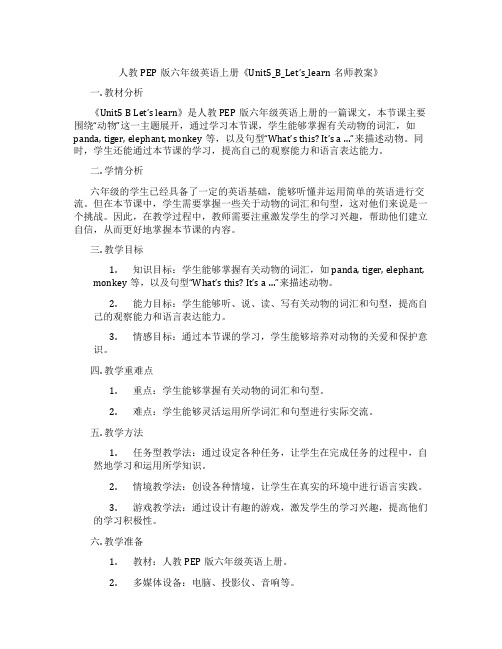
人教PEP版六年级英语上册《Unit5_B_Let’s_learn名师教案》一. 教材分析《Unit5 B Let’s learn》是人教PEP版六年级英语上册的一篇课文,本节课主要围绕“动物”这一主题展开,通过学习本节课,学生能够掌握有关动物的词汇,如panda, tiger, elephant, monkey等,以及句型“What’s this? It’s a …”来描述动物。
同时,学生还能通过本节课的学习,提高自己的观察能力和语言表达能力。
二. 学情分析六年级的学生已经具备了一定的英语基础,能够听懂并运用简单的英语进行交流。
但在本节课中,学生需要掌握一些关于动物的词汇和句型,这对他们来说是一个挑战。
因此,在教学过程中,教师需要注重激发学生的学习兴趣,帮助他们建立自信,从而更好地掌握本节课的内容。
三. 教学目标1.知识目标:学生能够掌握有关动物的词汇,如panda, tiger, elephant,monkey等,以及句型“What’s this? It’s a …”来描述动物。
2.能力目标:学生能够听、说、读、写有关动物的词汇和句型,提高自己的观察能力和语言表达能力。
3.情感目标:通过本节课的学习,学生能够培养对动物的关爱和保护意识。
四. 教学重难点1.重点:学生能够掌握有关动物的词汇和句型。
2.难点:学生能够灵活运用所学词汇和句型进行实际交流。
五. 教学方法1.任务型教学法:通过设定各种任务,让学生在完成任务的过程中,自然地学习和运用所学知识。
2.情境教学法:创设各种情境,让学生在真实的环境中进行语言实践。
3.游戏教学法:通过设计有趣的游戏,激发学生的学习兴趣,提高他们的学习积极性。
六. 教学准备1.教材:人教PEP版六年级英语上册。
2.多媒体设备:电脑、投影仪、音响等。
3.教具:动物图片、卡片等。
4.课件:根据教学内容设计的课件。
七. 教学过程1.导入(5分钟)教师通过播放一首关于动物的歌曲,引起学生的兴趣,然后问学生:“你们喜欢动物吗?为什么?”让学生发表自己的看法,从而引出本节课的主题。
人教版PEP六年级上册英语六上-U1-B-Learn--
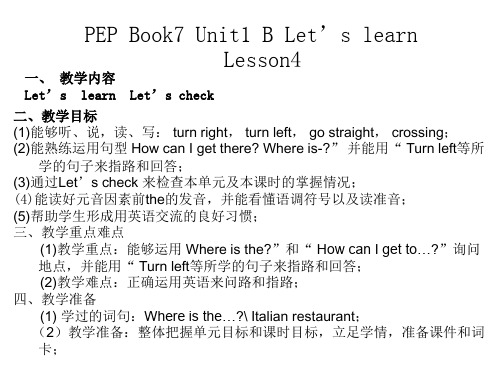
Turn left.
crossing Turn right.
Rules(规则) 1.A说walk,B往前走。 2.A说stop,B停下来。 3.A说turn left,B就…
Go straight.
t u_ _rn r _i g_ _ht t u_ _rn l _e _ft go stra_ i_ g_ h_ t cr_o ss _i n_ _g
straight/ Turn you can see the
.
B C
D A
Read and draw the route.(P4)
A:Excuse me.Where is the library?
B:Go straight. Turn right at theaight again. Then turn left at the gym.The library is next to the gym.
wait
paint
rainy
When(每当) you see the sign
,
Don’t _g_o__ __s_t_r_a_ig_h__t.
Read after it.
Mike: Where is the Italian restaurant? Turn right here?
at the crossing
学的句子来指路和回答; (3)通过Let’s check 来检查本单元及本课时的掌握情况; (4)能读好元音因素前the的发音,并能看懂语调符号以及读准音; (5)帮助学生形成用英语交流的良好习惯; 三、教学重点难点
(1)教学重点:能够运用 Where is the?”和“ How can I get to…?”询问 地点,并能用“ Turn left等所学的句子来指路和回答; (2)教学难点:正确运用英语来问路和指路; 四、教学准备 (1) 学过的词句:Where is the…?\ Italian restaurant; (2)教学准备:整体把握单元目标和课时目标,立足学情,准备课件和词 卡;
- 1、下载文档前请自行甄别文档内容的完整性,平台不提供额外的编辑、内容补充、找答案等附加服务。
- 2、"仅部分预览"的文档,不可在线预览部分如存在完整性等问题,可反馈申请退款(可完整预览的文档不适用该条件!)。
- 3、如文档侵犯您的权益,请联系客服反馈,我们会尽快为您处理(人工客服工作时间:9:00-18:30)。
Ways to go to school B let’s learn & Role play
一、教学目标
1.能够正确听说,朗读Stop and wait at a red light.Slow down and stop at a yellow light.Go at a green light.并能在实际情景中运用。
2.能够正确听说,认读单词,如slow down,stop,wait。
3.了解一些简单的交通标志,增强学生的交通意识。
二、教学重难点
1.重点:能够正确听说,认读单词,如slow down,stop,wait。
2.难点:Stop and wait at a red light.Slow down and stop at a yellow light.Go at a green light.并能在实际情景中运用。
三、教学准备:多媒体课件,单词图片。
四、教学过程:
(一)Warm-up
1.Greeting
2.Let’s chant “How do you come to school?”两遍
3.Free talk
T:Good morning!How do you come to school?复习如何询问别人出行方式句型。
学生可根据实际情况进行回答。
教师由对话总结引出T:Some students come to school by bike, some students come to school on foot. When you come to school, what must you remember?引出交通规则。
(二)Presentation
1.Let’s learn
(1)再次总结交通规则。
T:大家听一听MIKE有哪些地方做的不对,他应该怎么做呢?
(2)由traffic lights 引出There are red ,yellow and green. Red means stop, green means go, yellow means wait.
(3)教师板书新单词,用肢体语言解释做slow down, wait, stop, go的动作。
(4)学生跟读,开火车读,检查读,同时做出相应的动作。
(5)出示每一种交通灯,把单词放到句子中,教师用英语解释并配有动作,用英语来解释刚才听力中Mike的错误,引出新知:
Stop and wait at a red light. Slow down and stop at a yellow light. Go at a green light.
(6)再放一次录音,学生跟读。
(7)活动:小交警
活动方式:就哦啊是发出“Stop and wait”的指令时,学生要举起红灯并重复指令。
举措的学生则被判出局,坚持到最后的获胜。
(8)Practice in pairs。
同桌之间进行操练,其中一人任意举起一个交通灯,另一个学生做出相应的动作,并说出该交通规则。
2.Role play
四个同学一组,老师给同学们发一个交警帽和三盏交通灯,让一位学生扮演交警,指挥交通,其他同学根据所示的灯做出动作并说出相应的句子,对表现好的学生进行奖励。
轮流几回合后,总结规则,完成探究学习第二题。
3.Summary:what have you learned today ?并进行情感教育,PPT出示一些交通事故的图片,珍爱生命,遵守交通规则。
4. Homework
1.Listen and recite the dialogue.听录音并背诵对话。
五、板书设计:
Unit 2 Ways to go to school
Stop and wait at a red light.
Slow down and stop at a yellow light.
Go at a green light.
六、教学反思:。
